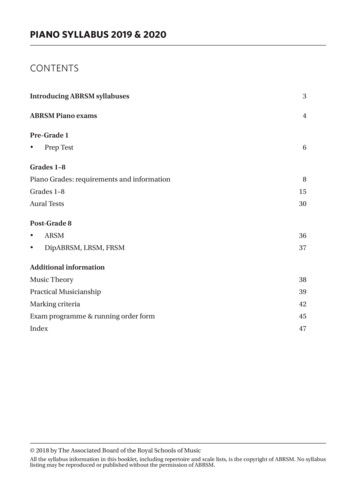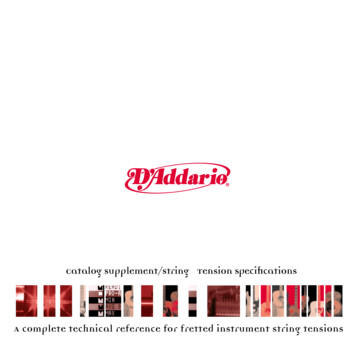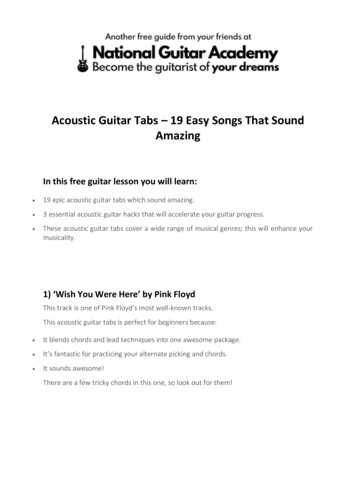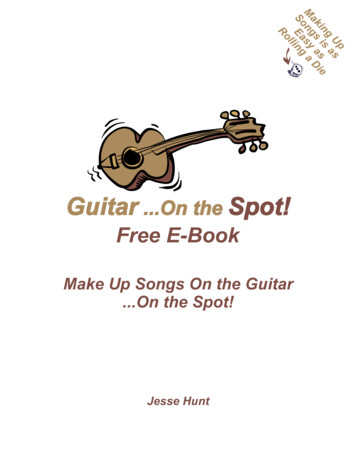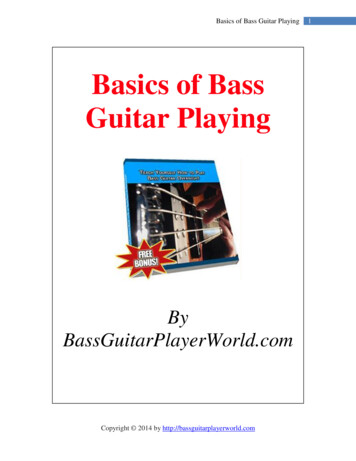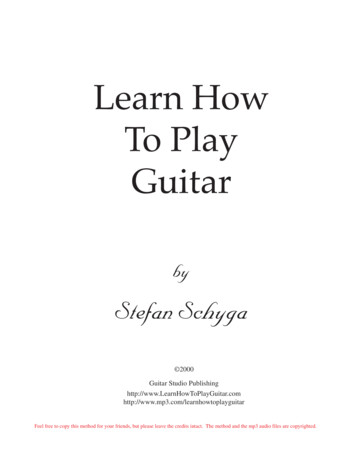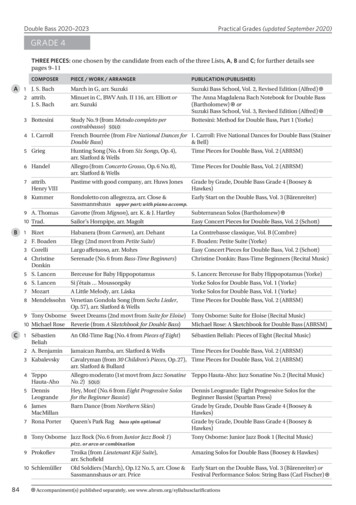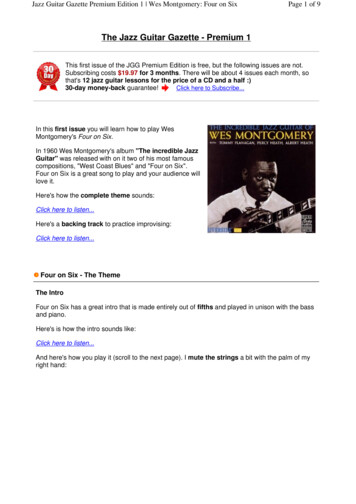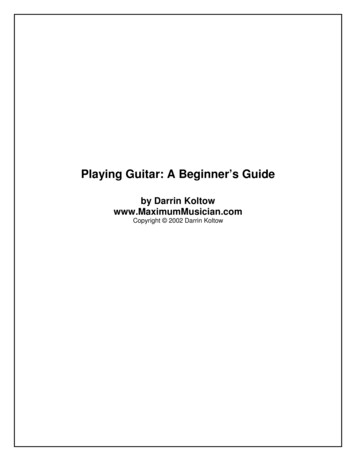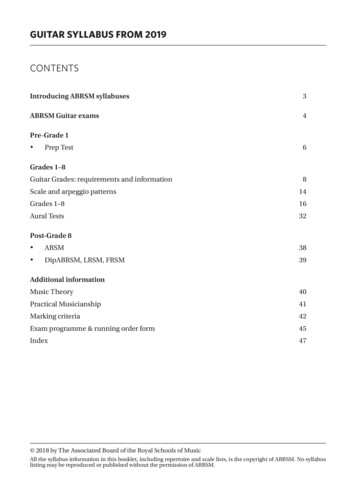
Transcription
GUITAR SYLLABUS FROM 2019CONTENTSIntroducing ABRSM syllabuses3ABRSM Guitar exams4Pre-Grade 1 Prep Test6Grades 1–8Guitar Grades: requirements and information8Scale and arpeggio patterns14Grades 1–816Aural Tests32Post-Grade 8 ARSM38 DipABRSM, LRSM, FRSM39Additional informationMusic T heory40Practical Musicianship41Marking criteria42Exam programme & running order form45Index47 2018 by T he Associated Board of the Royal Schools of MusicAll the syllabus information in this booklet, including repertoire and scale lists, is the copyright of ABRSM. No syllabuslisting may be reproduced or published without the permission of ABRSM.
2
INTRODUCING ABRSM SYLLABUSESAt ABRSM we are passionate about music and aim to support students and teachers in every waywe can. One way we do this is through our graded music exams. T hese assessments provide cleargoals, reliable and consistent marking, and guidance for future learning. T hey are a tried andtested way to inspire musical achievement and, with backing from four Royal Schools of Musicin the UK, are valued and trusted around the world.We offer graded music exams for a range of instruments (including singing) and genres, as wellas for Music T heory and Practical Musicianship. T he syllabuses are based on core musical skills– listening, performing, reading, writing, and musical knowledge and understanding. Togetherthese skills give students a good foundation for their musical development and a range ofdifferent musical activities.Taking an exam is an exciting challenge with many benefits for students. T here’s the boost tomotivation which comes from working towards an exam. T here’s an opportunity to discoverand perform some fantastic music and to build new skills. And there’s the sense of achievementwhich comes from successfully reaching a musical goal.We do everything we can to make the exam experience positive and rewarding. We work closelywith specialists, teachers and examiners to provide syllabuses of the highest quality with a widevariety of pieces and songs to choose from. We train our friendly, expert examiners to helpcandidates do their best in their exams. Using our clear, easy-to-understand marking criteriaexaminers can assess all candidates reliably, objectively and consistently. Finally, candidatesreceive a mark form containing valuable feedback, with a celebratory certificate for everyonewho passes.Whether you’re a student or teacher, we hope this syllabus inspires and supports your musiclearning or teaching. We wish you every success for your musical journey!Find out more at www.abrsm.org.3
ABRSM GUITAR EXAMST his syllabus booklet is designed to help teachers, candidates, parents and organizations whenpreparing for ABRSM graded Guitar exams.T he Guitar syllabus is listed, grade by grade, on pp. 16–31 and shows the requirements for theexams. Important additional information can be found on pp. 8–13. T he Aural tests featured inall ABRSM graded exams are described on pp. 32–37. In addition, this booklet outlines ABRSM’spre-Grade 1 and post-Grade 8 guitar assessments as well as the supporting subjects of MusicT heory and Practical Musicianship which contribute to all-round musical development.As well as reading this booklet, it is important to consult ABRSM’s Exam Regulations, availableat www.abrsm.org/examregulations.Guitar syllabus from 2019T his booklet is valid for graded exams from 1 January 2019 until further notice.T here are new set pieces.All other requirements – Scales and arpeggios, Sight-reading and Aural tests – remain unchangedfrom the preceding syllabus.Any updates during this syllabus’s lifetime – e.g. changes to publication details or other minorcorrections or clarifications – will be posted at www.abrsm.org/syllabuscorrections.Other changes made in this syllabus/booklet are: the duet option previously offered at Grades 1–3 is extended to Grade 5an accompanied option is now available at Grade 8some clarification of key exam information, including a table of the sight-reading parametersfor easy referencethe inclusion of information about the Guitar Prep Test (a fully revised test is introduced for2019)the inclusion of information about the post-Grade 8 qualifications available for guitar.Overlap of syllabusesIn the first year of any new Practical syllabus, ABRSM offers an overlap period in whichcandidates may play specific requirements from the preceding syllabus.Information on the overlap duration and the specific requirements to which the overlap periodapplies can be found at www.abrsm.org/overlap.T he next syllabusAt the time of publication of this booklet, the next revision of the Guitar syllabus had not beenscheduled. Advance notice of any planned changes to the guitar requirements (includingsyllabus overlap information) will be posted in advance at www.abrsm.org/guitar.4
ABRSM Guitar examsOther assessments for GuitarABRSM’s other Guitar assessments are the Prep Test (see p. 6), Music Medals, PerformanceAssessment, Ensembles and diplomas (see pp. 38–39). Further information is available at www.abrsm.org/exams.Regulation and UCAS points (UK)ABRSM graded music exams, Music Medals and diplomas are regulated in England by the Officeof Qualifications and Examinations Regulation (Ofqual) and the corresponding regulatoryauthorities in Wales (Qualifications Wales) and Northern Ireland (CCEA Regulation). T hey arepart of the Regulated Qualifications Framework (RQF) in England and Northern Ireland.In the UK, ABRSM’s Grade 6–8 exams can contribute towards entry into higher educationthrough the allocation of UCAS points.For further information, see www.abrsm.org/regulation.5
GUITAR PREP TESTABRSM’s Prep Test, presented in a relaxed and encouraging way, is an ideal introduction to theexam experience. It gives students a goal to work towards and a certificate awarded on the day –something to be really proud of.T he Prep Test is designed to encourage the development of good musical and technicalfoundations. It covers many of the elements beginners will be working on at this early stage,including pitch, time, tone, performance and musical perception.ContentT he Guitar Prep Test consists of four sections – Tunes, two Pieces, and Listening Games: TunesT hree short exercises played from memory:a) Pigeon Stepsb) Hopping Rabbitc) Leaping KangarooFirst Piece (solo or duet)Any one of the following solos:Uptown Shuffle (Tim Pells)T he Wobbegong Waltz (Abigail James)T he Old Firework-Maker (Helen Sanderson)orEither of the following duets (which may,alternatively, be performed as solos):Danza española (Laura Snowden)Waddling Ducks (Gary Ryan)orAny piece marked with a from: ÓÏ Guitar Prep Test book Guitar Prep Test bookGuitar StarSecond Piece (solo, duet or accompanied)Own-choice piece (c.16–24 bars)T his can be any piece you like, including one from the Guitar Prep Test book or Guitar Star. Listening Games*Four listening games:a) Clapping the beatb) Echoesc) Finding the notesd) What can you hear?Examples are provided in the Guitar Prep Test book.* For deaf or hearing-impaired candidates, further information is available at www.abrsm.org/specificneeds.6
Guitar Prep TestT he books mentioned on p. 6 are published by ABRSM and are available from music retailers aswell as online, including at the ABRSM music shop: www.abrsm.org/shop.Details for the Guitar Prep Test book refer to the newly revised edition (2018). ABRSM offers anoverlap period in which candidates may continue to use the previous edition (2001) for a limitedtime. Information on the overlap duration can be found at www.abrsm.org/overlap.AssessmentImmediate feedback is given on the day, in the form of positive comments and suggestionswritten on the certificate, which is handed to the candidate by the examiner at the end of thePrep Test. T here is no pass or fail, and no marks are awarded. T he examiner’s comments willcover some of the following: Sense of pitchSense of rhythmControl of toneListening skills and awarenessOther information T he Prep Test takes about 10 minutes. All ABRSM public venues provide a music stand and the examiner will be happy to help adjustthe height or position of the stand. Candidates should provide their own footstool (or otherform of guitar support) if required. T he guitar should be tuned before entering the exam room, but in cases where the candidateis playing with a piano accompaniment the teacher or accompanist may tune the candidate’sinstrument to the piano (or advise on tuning) before the exam begins. Examiners are unableto help with tuning. T he Tunes should be performed from memory, but the two Pieces can be played from themusic. If either of the Pieces is played from memory, candidates should bring a copy of themusic for the examiner. If choosing to play a duet, candidates should bring their own duet partner. Duets chosen fromthe Guitar Prep Test book or Guitar Star may, alternatively, be performed as solos. T he examiner will be happy to play any piano accompaniment for the Second Piece, in whichcase candidates should bring the music with them. Alternatively, candidates can bring theirown accompanist if they prefer. Generally, there will be one examiner, although sometimes a second examiner may also bepresent. Details of dates, venues, fees and how to book a Prep Test are available online at www.abrsm.org/exambooking.7
GUITAR GRADES: requirements and informationT his syllabus is valid from 2019 until further notice.T his section provides a summary of the most important points that teachers and candidates needto know when taking ABRSM graded Guitar exams. Further details, as well as administrativeinformation relating to the exams, are given in ABRSM’s Exam Regulations (available at www.abrsm.org/examregulations) which should be read before an exam booking is made.Entering for an examEligibility: T here are eight grades of exam for Guitar and candidates may be entered for anygrade irrespective of age and without previously having taken any other grade in Guitar.Candidates for a Grade 6, 7 or 8 exam must already have passed ABRSM Grade 5 (or above) inMusic Theory, Practical Musicianship or a solo Jazz instrument; for full details, including a list ofaccepted alternatives, see www.abrsm.org/prerequisite.Access: ABRSM endeavours to make its exams as accessible as possible to all candidates,regardless of sensory impairments, learning difficulties or particular physical needs. T here is arange of alternative tests and formats as well as sets of guidelines for candidates with particularaccess needs (see www.abrsm.org/specificneeds). Where a candidate’s needs are not covered bythe guidelines, each case is considered on an individual basis. Further information is availablefrom the Access Co-ordinator (accesscoordinator@abrsm.ac.uk).Exam booking: Details of exam dates, locations, fees and how to book an exam are availableonline at www.abrsm.org/exambooking.InstrumentsT his syllabus is only appropriate for the standard classical instrument fitted with nylon strings(guitars with a cutaway body are permitted). Candidates may choose to use a capo at the 2nd or3rd fret for the pieces in Grades 7 and 8 that have an optional F# tuning; no other use of the capois permitted unless specified by the composer.Elements of the examAll ABRSM graded Guitar exams comprise the following elements: three Pieces; Scales andarpeggios; Sight-reading; and Aural tests. In all grades, marks are allocated as follows:Pieces: 123Scales and arpeggiosSight-readingAural testsTotal303030212118150Marking scheme: 100 marks are required for a Pass, 120 for a Merit and 130 for a Distinction.A Pass in each individual section is not required to pass overall. See pp. 42–43 for the markingcriteria used by examiners.8
Guitar grades: requirements and informationPiecesProgramme planning: Candidates must choose one piece from each of the three lists (A, B andC) in each grade (see also ‘Accompaniment’ below). In the exam, they should inform the examinerwhich pieces they are performing, and they are welcome to use the form on p. 45 for this purpose.Every effort has been made to ensure the syllabus lists feature a broad range of repertoire, withitems to suit and appeal to candidates of differing ages, backgrounds and interests. Not everypiece will be suitable for every candidate due to technical reasons (e.g. hand size) or widercontext (historical, cultural, subject matter of the larger work from which it is drawn, lyrics if anarrangement of a song etc.). It is advised that pieces selected are considered carefully for theirappropriateness to each individual, which may require consultation between teachers andparents/guardians. Given the ever-changing nature of the digital world, teachers and parents/guardians should also exercise caution when allowing younger candidates to research itemsonline: www.nspcc.org.uk/onlinesafety.Accompaniment: In Grades 1–3, candidates may perform up to two pieces accompaniedby another guitar (or, if necessary, a piano); in Grades 4 and 5, only one such piece may beperformed. In Grade 8, candidates may perform one piece accompanied by piano.Accompanied pieces are marked with aor in the syllabus. None of the pieces marked withain Grades 1–5 or a in Grade 8 may be performed solo. All other pieces must be performedsolo.Candidates must provide their own accompanist, who may remain in the exam room onlywhile accompanying. T he candidate’s teacher may act as accompanist (examiners will not). Ifnecessary, the accompanist may simplify any part of the accompaniment, provided the result ismusically satisfactory. Recorded accompaniments are not allowed.Exam music & editions: Wherever the syllabus includes an arrangement or transcription, theedition listed in the syllabus must be used in the exam; in all such cases the abbreviation ‘arr.’ or‘trans.’ appears in the syllabus entry. For all other pieces, the editions quoted in the syllabus aregiven for guidance only and ca
Guitar Prep Test book First Piece (solo or duet) Any one of the following solos: Uptown Shuffle (Tim Pells) The Wobbegong Waltz (Abigail James) The Old Firework-Maker (Helen Sanderson) or Either of the following duets (which may, alternatively, be performed as solos): Danza española (Laura Snowden) Waddling Ducks (Gary Ryan) or Any piece marked with a from: Guitar Star Second Piece (solo .
